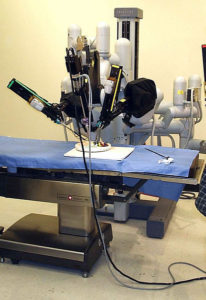Ovarian cysts are a common condition that many women encounter. Many times, ovarian cysts are small enough not to cause problems. However, when they disrupt nearby tissue or begin causing pain, doctors may need surgically remove them surgically.

What is it?
An ovarian cystectomy involves the removal of cysts that have formed in or on the ovaries. Recently, robotic tools have been able to develop laparoscopic surgeries, usually resulting in less pain and faster recovery times for the patient. Robotic ovarian cystectomies aim to remove different kinds of ovarian growths using laparoscopic tools, reducing the size of surgical incisions and making surgery quicker than traditional procedures.
How to Prepare
General anesthesia will likely be used for this procedure, so inform your doctor of any allergies to medications. The day before the surgery, your doctor may ask you to drink medications to help clear your intestines. Blood and urine tests may also be conducted in the weeks before the surgery. CT, MRI, and ultrasound imaging tests will be performed to help surgeons visualize the ovaries. Patients should be prepared for possible infertility following the surgery and should consult a doctor if they experience problems becoming pregnant.
What happens during the process?
During a robotic ovarian cystectomy, the surgeon will operate robotic tools from a console while the patient is on the operating table. After a few small incisions are made, the surgeon inserts the robotic arms and locates the cysts. The cysts are then removed from the ovaries. If the surgeon cannot remove the entire cyst, he/she may only remove as much as they can. After removing the cysts, the incisions are sealed and the patient can usually recover within a few weeks.
Risks and Complications
- Ovarian torsion (painful twisting of the ovary)
- Rupture of the cyst (causing contents to spread throughout the pelvis)
- Excessive bleeding
- Infection
Disclaimer:
All GlobeHealer Site content, including graphics, images, logos, and text, among other materials on the site are for educational purposes only. This content is not intended to be a substitute for professional medical advice, and you should always contact your physician or qualified health provider for information regarding your health. Information on this site regarding the overview, diagnosis, and treatment of any kind should be looked at, in addition to the advice and information of your health care professional. Do not disregard medical advice or delay seeking treatment or medical advice due to information found on the GlobeHealer site.
If there is even the possibility that you may have a medical emergency, seek treatment, call your doctor, or call your local emergency telephone number immediately. GlobeHealer does not endorse being the first line of communication in case of emergency and does not endorse any specific test, physician, facility, product, procedure, opinion, or other information that is or may be mentioned on this site or affiliated entities. Reliance of any and all information provided by GlobeHealer, its employees, affiliations, others appearing on the Site under the invitation of GlobeHealer, or visitors of the site is solely at your own risk and is not the responsibility of GlobeHealer.
Image Source:
https://commons.wikimedia.org/wiki/File:Laproscopic_Surgery_Robot.jpg
